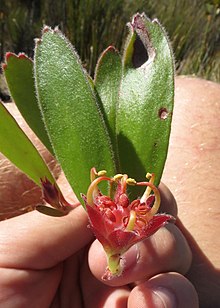Leucospermum hamatum
| Leucospermum hamatum | |
|---|---|

| |
| Scientific classification | |
| Kingdom: | Plantae |
| Clade: | Tracheophytes |
| Clade: | Angiosperms |
| Clade: | Eudicots |
| Order: | Proteales |
| Family: | Proteaceae |
| Genus: | Leucospermum |
| Species: | L. hamatum
|
| Binomial name | |
| Leucospermum hamatum | |
Leucospermum hamatum is mat-forming, evergreen shrublet of only about 10 cm (3.9 in) high, from the Proteaceae. It is usually 1–3 m (3.3–9.8 ft) in diameter, has long trailing stems and upright, inverted lance-shaped, entire leaves but for one to five shallow reddish bony teeth near the tip. Its small flower heads of 1½–2 cm (0.6–0.8 in) in diameter, consist of four to seven drab carmine-colored flowers that strongly curve back to the centre of the head. It mainly flowers from July till November and is pollinated by mice.[3] It has been given the common name Ruitersbos pincushion.[4]
Description
Leucospermum hamatum is a crawling low shrub of no more than 10 cm (3.9 in) high that can form dense mats of 1–3 m (3.3–9.8 ft) in diameter, with stout branches of up to 2½ cm (1 in) thick that stretch out along ground and originate from a central stout trunk of up to 4½ cm (1.8 in) thick. The flowering branches are slim, trailing along the ground, frequently divided in two, about 2 mm (0.079 in) thick, with very few soft long hairs, mostly with one flower head at the tip of the branches and several in the axils of the furthest leaves. The leaves are alternately set, upright, narrowly oblong to oblong-elliptic, 4½–6½ cm (1.8–2.6 in) long and 8–18 mm (0.31–0.71 in) wide, set on a leaf stalk of up to ½ cm (0.2 in) long. Near the leaf tip are usually about three teeth, sometime the margin is wholly entire. The surface of the leaf is initially slightly powdery, but this is lost later on.[3]
The flower head is 1½–2 cm (0.6–0.8 in) in diameter and consists of four to seven flowers in one whorl set on a
The subtribe Proteinae, to which the genus Leucospermum has been assigned, consistently has a basic chromosome number of twelve (
Taxonomy
L. hamatum was named and described by John Patrick Rourke in 1983. The species name hamatum is derived from the Latin word meaning "hooked" and refers to the barbs near the tip of the styles.[3][6][7] L. hamatum is the type species of the section Hamatum.[8]
Distribution, habitat and ecology
Leucospermum hamatum is only known from one location on the Klein Moeras River Farm, in the northern foothills of the
Conservation
The Ruitersbos pincushion is considered endangered. Only five small subpopulations are known, spread over an area of about 20 km2. It may be threatened by the invasive Hakea, which has been removed from the direct neighborhood of L. hamatum, but which may spread again if it is not managed.[4]
References
- . Retrieved 18 November 2021.
- ^ = Leucospermum "Leucospermum". The Plantlist.
{{cite web}}: Check|url=value (help) - ^ a b c d e Rourke, John Patrick (1983). "A remarkable new Leucospermum (Proteaceae) from the southern Cape". Journal of South African Botany. 49 (3): 213–219.
- ^ a b "Ruitersbos Pincushion". SANBI Threatened Species Programme.
- ]
- ^ "hamatum". Definitions.
- ISBN 9780470650721.
- ^ "Identifying Pincushions". Protea Atlas Project.
- ^ "Pollination of Proteas". Protea Atlas Project.

